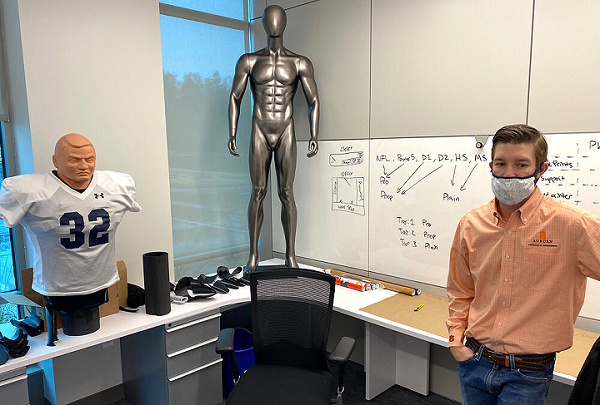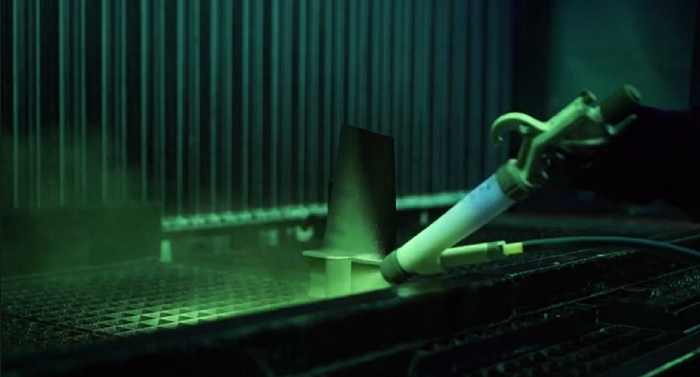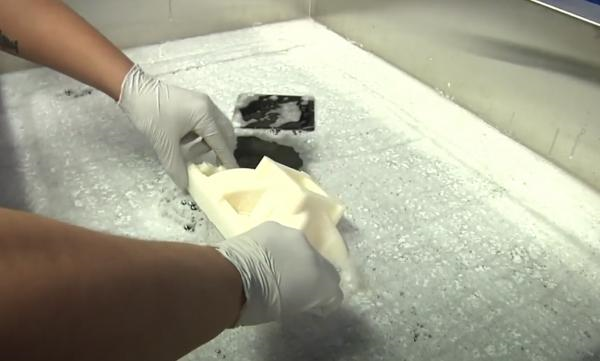3D Printing News Briefs, February 24, 2021: Auburn University, Vector Photonics, Siemens Energy, Omegasonics, Bugatti, Hackaday
We’re starting with some business in 3D Printing News Briefs today, talking about Auburn University’s Additive Manufacturing Accelerator and Vector Photonics leading the BLOODLINE consortium, which I promise isn’t as weird as its name would suggest. Moving on, Siemens Energy has come up with a way to use 3D printing to upgrade turbine blades rather than repairing them, and Omegasonics has introduced its updated ultrasonic cleaning equipment for 3D printed parts. Finally, the Bugatti Bolide hypercar features a multitude of 3D printed components, and a Hackaday post details how to make a DIY HEPA filter fan with some 3D printed pieces.
Auburn University’s AM Accelerator Targets 3D Printing Startups

Auburn University Professor Michael Zabala operates XO Armor out of office in the university’s innovation park on the city’s southwest side. (Image courtesy of Mike Eads, Opelika-Auburn News)
Officials from the city of Auburn, Alabama are offering local entrepreneurs and faculty from Auburn University the chance to help grow a new industry by joining the Additive Manufacturing Accelerator, a partnership program between the National Center for Additive Manufacturing Excellence, the university, and the city’s Training Connection that runs through the fall of 2021. The Accelerator targets startups that use 3D printing, and offers funding and advice to help with things like establishing manufacturing processes, hiring employees, and finding customers. The goal is to help ten local companies and three startups, and provide a new local industry and student training opportunities. One of the Accelerator’s first clients is Auburn University Professor Michael Zabala, who teaches mechanical engineering with an emphasis on human biology. At the request of one of the university’s football trainers, he created bespoke padding for a player in 2019, and XO Armor was born. Athletes use the startup’s app to scan ankle, elbow, knee, and shoulder joints, then send the specifications to XO, which then creates and delivers a pad or brace to help disperse the energy from a field collision and protect the joint.
“In biomechanics, we analyze the human body, how it moves and the forces and motions associated with that,” Zabala explained. “That’s the relationship between mechanical engineering and what we’re doing here: using 3D printing and other manufacturing techniques to make devices that work extremely well with the complicated human body.”
The AM Accelerator will help Zabala create local jobs, training opportunities for engineering students, and scale XO Armor.
Vector Photonics Leading BLOODLINE Consortium
According to SmarTech Analysis, the market for metal laser 3D printing will skyrocket to $10 billion by the year 2025. As such, Vector Photonics is leading an Innovate UK-funded international consortium project to develop metal 3D printing chips based on its own PCSELs (Photonic Crystal Surface Emitting Lasers). Other partners in the £1.5 million Project BLOODLINE, which stands for “Bright Laser diOdes fOr aDvance metaL addItive maNufacturing systEms,” are the UK’s Compound Semiconductor Applications (CSA) Catapult, a Japanese manufacturer of semiconductors, and a Japanese industrial equipment manufacturer. The PCSEL chips should be suitable for any 3D printer manufacturer to use.
“3D metal laser printers hold metal powder in a ‘powder bed’ at just below melting point. Currently, CO2 or fibre lasers, directed by mirrors, scan over the surface of the powder, melting the metal powder to the layer below, in what is termed Selective Laser Melting (SLM),” explained Dr Richard Taylor, CTO at Vector Photonics, and Enterprise Fellow at the Quantum Technology Enterprise Centre.
“Vector Photonics’ PCSEL technology will revolutionise the SLM process. PCSELs offer a unique combination of increased laser power, by scaling up the PCSEL arrays; improved reliability, by removing the mirrors and offering and entirely solid-state solution; and greater manufacturing efficiency – the result of higher resolution printing with less finishing overheads and faster printing speeds.
“We believe that PCSELs will enable an entirely new class of next generation, metal printers and contribute to even greater market growth.”
Siemens Uses Hybrid 3D Printing to Add Features to Turbine Blades
One SGT5-4000F gas turbine blade converts as much power into rotational energy as there is in ten Porsche 911 sports cars. Because of the high gas velocities and temperatures that occur when you operate a gas turbine, you often see burn-off at the blade tip, which can lead to gaps between the tip and the ring segment and decrease turbine performance. AM and repair experts at Siemens Energy figured out how to use a hybrid 3D printing process to upgrade broken turbine blades, rather than repairing them, by adding high-resolution cooling structures in important areas in order to prevent the blade tip from failing. The technology used here was laser powder bed fusion (L-PBF) metal 3D printing, and this new design can help cool critical blade areas more effectively, which can prevent material loss resulting from burn-off.
Applying AM to existing components, called Hybrid L-PBF Repair or HybridTech, is still a newer area that’s being explored, and is being developed as part of a European Regional Development Fund research project. Turbine blades that been operating at high temperature have different, individual shapes, which makes it difficult to complete L-PBF repair. So by pairing 3D scanning and a new algorithm, Siemens Energy developed a new CAD-CAM digital repair chain, which adapts the shape of 3D printed tip automatically so it’s a perfect match to the blade. The first sets of blades have already been completed, and the team is working to convert the standard repair procedures to add the new process, so it can be applied to other components in the future.
Omegasonics Updates Ultrasonic 3D Print Cleaning Technology
California-based Omegasonics has released its updated ultrasonic cavitation equipment for cleaning 3D printed parts, which can help lead to faster, more precise 3D printing. Once certain technical parts have been removed from the print bed, they normally need precise cleaning and preparation, and the manual, labor-intensive process of using heated circulation washers to do could take up to 24 hours, depending on part size. But with Omegasonics’ updated ultrasonic technology, cleaning time can be majorly reduced. The process removes support structures from materials such as Nylon 12, Polycarbonate, PCABS, and ABS, and keeps the part quality high while bringing labor costs down.
“It used to take a full day to manually remove support material from some 3D parts. Now we just put the parts into the ultrasonic cleaner and do something else while they’re being cleaned. After three hours, we have nice, clean parts,” Armen Boyajyan, Product Finishing Manager, of Stratasys Direct Manufacturing, said about working with Omegasonics.
This new technology is part of the company’s broader 2021 plan to support its clients, and it also plans to launch several new products, including a thermal dyeing station for 3D printed thermoplastic products and one for removing soluble supports.
Bugatti Bolide’s Lightweight 3D Printed Components
The Bugatti Bolide hypercar weighs in at just 1,240 kg, with a powerful 8 liter, quad-turbocharged W16 engine, and has a nearly unheard of power-to-weight ratio of 0.67 kg per horsepower, mainly thanks to the many lightweight metal 3D printed components it sports. The automaker has long used the technology to make components for its race cars, and the Bolide, while only a working concept at the moment, is no different. Its new titanium 3D printed pushrods are hollow, and even though they only weigh 100 grams, they can handle up to 3.5 tons of force, while the wheel-mounted radial compressors, which reduce lift and cool brakes at high speeds, are made with a 0.48 mm thick 3D printed titanium central bowl. The hollow front wing mounted bracket was also 3D printed using titanium, and the huge rear wing is held in place with a strong titanium 3D printed component. Last but not least, the Bolide steering column also features 3D printed hollow parts. All of these parts help the Bugatti Bolide go from zero to 60 mph in less than three seconds.
“As an experimental vehicle in the form of a racing car, the Bolide is no show car; it is an uncompromisingly road-ready extract of Bugatti’s complete technological expertise. Bugatti enthusiasts will also find these cutting-edge technologies in other vehicles in the future,” said Frank Götzke, Head of New Technologies at Bugatti.
“It is Bolide’s many technological highlights that make it so special. This is what we are continuing to develop and work on because Bugatti has set itself apart with its impressive innovations for over 100 years – and will continue to do so in the future.”
3D Printed Parts for DIY HEPA Fan
If you’re back in the office instead of working remotely during the COVID-19 pandemic, it can be uncomfortable spending so much time around other people in close quarters with only hand sanitizer and a face mask to protect you against germs. Hackaday published an interesting DIY project for a HEPA filtering fan by Thingiverse user jshanna, which looks pretty simple to build and features some black PLA 3D printed pieces, along with a few more commonly available parts such as nuts, washers, screws, thread brass inserts, and furniture pads. It looks like a quick, easy way to clear that stale air in your office.
“The basis of this attractive and useful office must-have is a muffin fan from Amazon that has an optional variable speed controller,” the Hackaday post reads.” A long threaded rod runs up the center of the HEPA filter, so it attaches kind of like a lampshade. The fan draws up air from underneath and blows it upward through the filter and out into the room. Whenever the HEPA filter gets dirty, just take it out and wash it.”
Subscribe to Our Email Newsletter
Stay up-to-date on all the latest news from the 3D printing industry and receive information and offers from third party vendors.
You May Also Like
3D Printing News Briefs, April 13, 2024: Robotics, Orthotics, & Hypersonics
In 3D Printing News Briefs today, we’re focusing first on robotics, as Carnegie Mellon University’s new Robotics Innovation Center will house several community outreach programs, and Ugogo3D is now working...
Rail Giant Alstom Saves $15M with 3D Printing Automation Software 3D Spark
3D Spark has entered into a three-year deal with the rail giant Alstom. Alstom, a transport behemoth with annual revenues of $16 billion, specializes in the manufacture of trains, trams,...
Meltio Expands Global Reach with New Partnerships in the Americas and Europe
Spanish 3D printing manufacturer Meltio has expanded its sales network across the globe. With the addition of three new partners in the United States, Brazil, Argentina, and Italy, Meltio aims...
3D Printing Webinar and Event Roundup: April 7, 2024
Webinars and events in the 3D printing industry are picking back up this week! Sea-Air-Space is coming to Maryland, and SAE International is sponsoring a 3D Systems webinar about 3D...




































